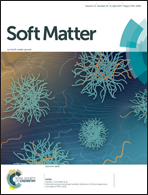Partial to complete wetting transitions in immiscible ternary blends with PLA: the influence of interfacial confinement†
Abstract
In this study it is shown that the three different intermediate phases in melt blended ternary PLA/PHBV/PBS, PLA/PBAT/PE and PLA/PE/PBAT systems all demonstrate partial wetting, but have very different wetting behaviors as a function of composition and annealing. The interfacial tension of the various components, their spreading coefficients and the contact angles of the confined partially wet droplets at the interface are examined in detail. A wetting transition from partially wet droplets to a complete layer at the interface is observed for both PHBV and PBAT by increasing the concentration and also by annealing. In contrast, in PLA/PE/PBAT, the partially wet droplets of PE at the interface of PLA/PBAT coalesce and grow in size, but remain partially wet even at a high PE concentration of 20% and after 30 min of quiescent annealing. The dewetting speed of the intermediate phase is found to be the principal factor controlling these wetting transitions. This work shows the significant potential for controlled wetting and structuring in ternary polymer systems.



 Please wait while we load your content...
Please wait while we load your content...